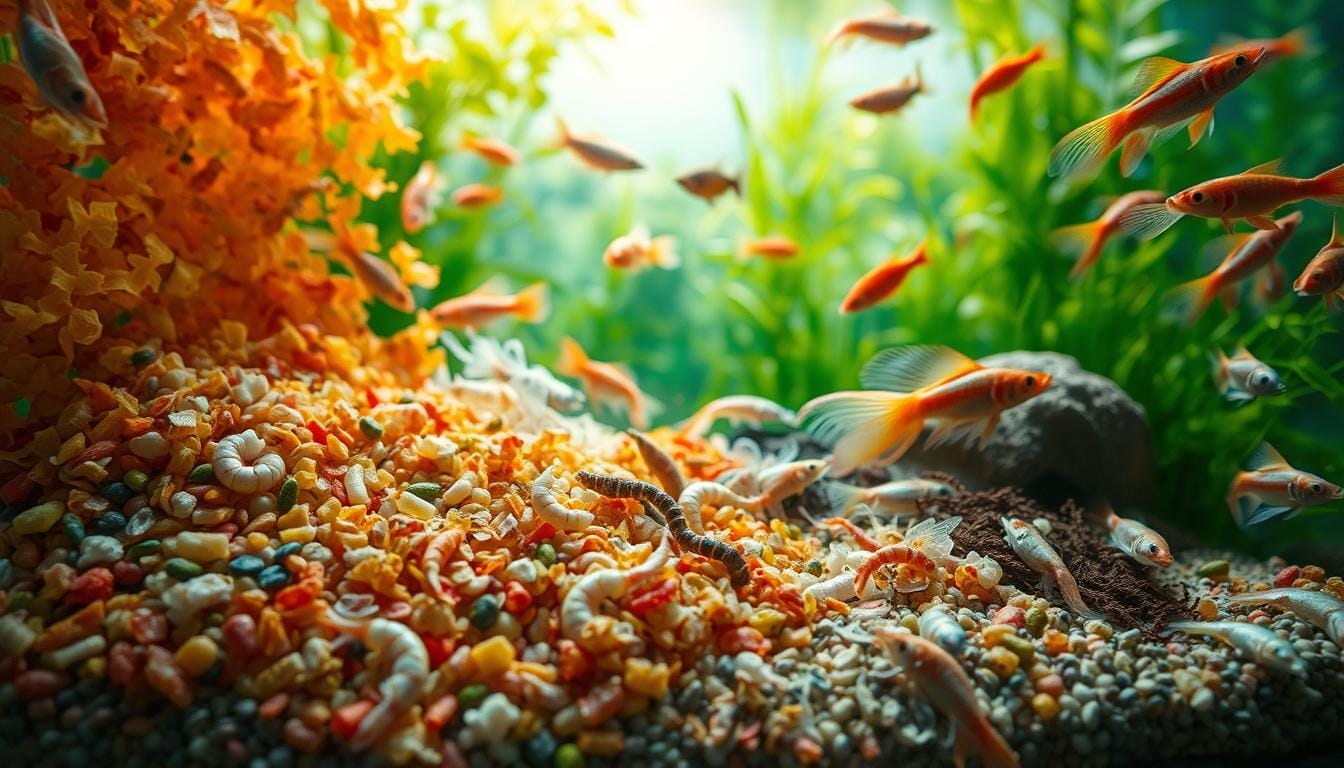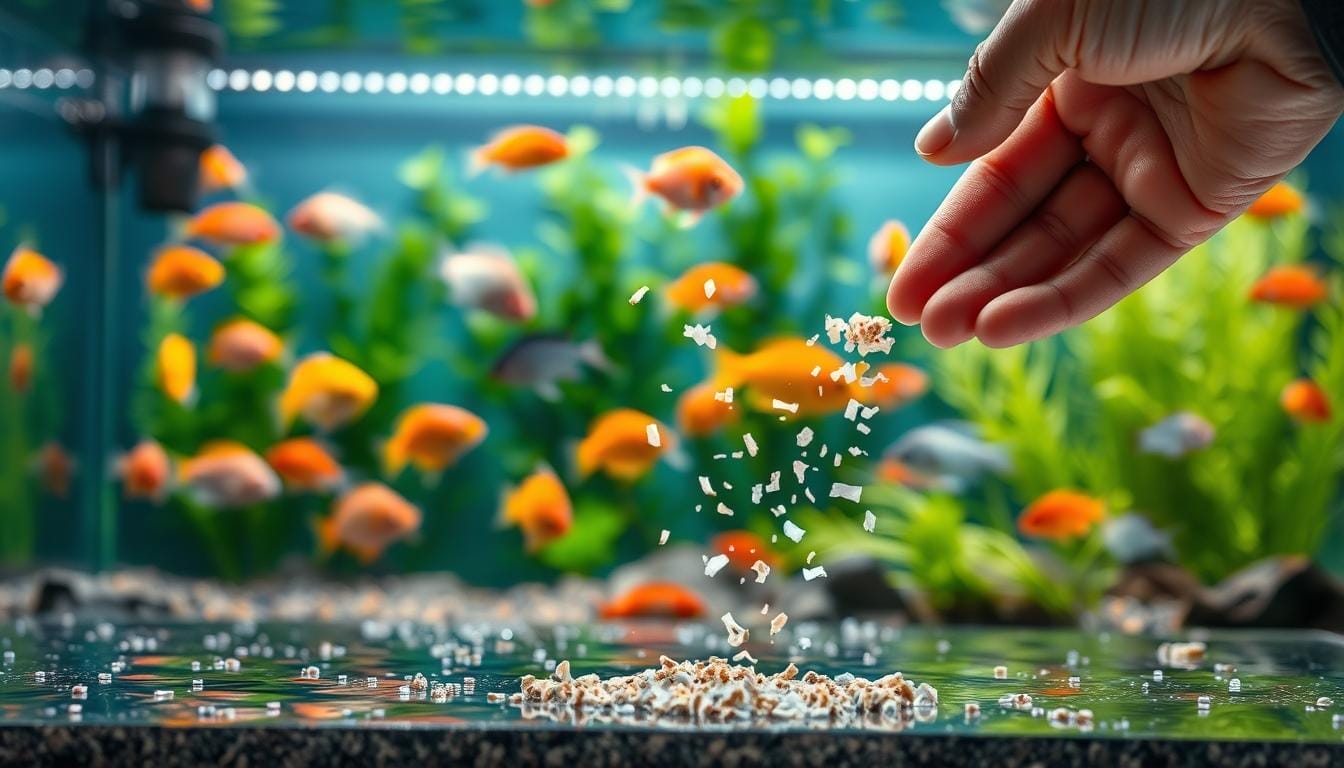
Discover the Benefits of Live Food Culture for Your Aquarium

Did you know 89% of expert fishkeepers report healthier, more vibrant aquatic life when using natural feeding methods? This simple shift unlocks behaviors and benefits commercial flakes simply can’t match.
Creating a self-sustaining ecosystem in your tank does more than feed your fish. It sparks their natural instincts, turning mealtime into enrichment. Watch your aquatic pets dart and hunt like they would in wild rivers or lakes.
Seasoned hobbyists swear by these systems for good reason. Live options offer complete nutrition missing from processed diets. Your finned friends get essential enzymes and nutrients preserved fresh, not dried or frozen.
You’ll notice changes quickly. Active swimming patterns emerge as fish engage with their environment. Breeding behaviors often follow, with many species showing readiness to spawn within weeks of dietary upgrades.
This approach bridges the gap between glass walls and natural habitats. Your aquarium becomes a dynamic space where every feeding strengthens the connection between captive life and wild roots. Ready to see the transformation?
Understanding the Concept of Live Food Culture
Imagine your fish chasing wiggling prey instead of nibbling sinking pellets. This active feeding experience lies at the heart of natural aquarium care. By cultivating small organisms, you create a dynamic buffet that mirrors what aquatic species encounter in their native habitats.
What Is This Feeding Method?
This approach involves raising nutrient-rich creatures like brine shrimp and daphnia in controlled environments. These tiny swimmers become self-renewing meals that grow alongside your aquarium’s needs. Unlike prepackaged options, these organisms stay alive until consumed, preserving vital enzymes.
Why It Outperforms Store-Bought Options
Commercial fish foods often lose nutritional value during processing. Live options deliver unmatched protein levels and fatty acids crucial for vibrant colors and immune health. Movement triggers your pets’ hunting instincts, promoting mental stimulation and physical exercise.
Three key advantages make this method stand out:
- Higher vitamin retention compared to dried alternatives
- Reduced waste from uneaten meals
- Customizable selection based on fish size and species
You’ll notice improved breeding behaviors and energy levels as your aquatic community thrives on these fresh, moving meals. It’s like upgrading from fast food to a farmers market – but for your finned friends!
Why Choose Live Foods for Your Aquarium
Your aquarium inhabitants thrive when their meals mirror nature’s design. Wiggling prey sparks instinctual feeding responses, turning every bite into an energy-packed hunt. This method isn’t just about sustenance—it’s about unlocking your aquatic pets’ full biological potential.
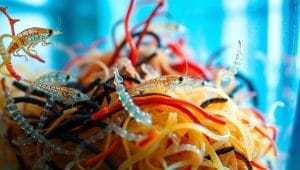
Nutritional Advantages for Fish Health
Fresh prey delivers untouched proteins and amino acids that processed diets lose during manufacturing. Enzymes in living organisms aid digestion, helping your pets absorb more nutrients per meal. Species like bettas and guppies often show brighter colors within weeks of switching to this live aquarium food approach.
Breeding fish benefit most. High-energy meals prepare their bodies for spawning, increasing egg production and fry survival rates. It’s like giving athletes a pre-game feast tailored to their needs.
Enhancing Natural Foraging Behavior
Watch timid fish transform into confident hunters. Chasing meals keeps fins strong and minds sharp—critical for species that naturally graze all day. Underweight specimens often bulk up faster when movement triggers their appetite.
Three key changes you’ll notice:
- Increased surface activity during feeding times
- Territorial species displaying vibrant mating colors
- Bottom-dwellers exploring new tank areas
This isn’t just feeding—it’s environmental enrichment. Your tank becomes a stage for behaviors hidden since your pets left wild waters.
Setting Up Your Live Food Culture at Home
Your kitchen holds the key to a thriving aquatic ecosystem. With everyday items and basic know-how, you’ll create a self-sustaining buffet that keeps your fish active and nourished. Let’s turn spare space into a mini hatchery!
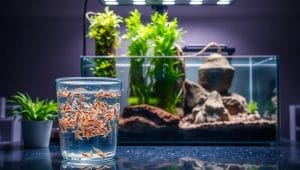
Required Equipment and Containers
Start with containers you already own. Small plastic bins work for microworms, while wine bottles become vinegar eel nurseries. Larger tanks (1-5 gallons) suit daphnia and brine shrimp. You’ll need:
- Air pumps for oxygen-rich environments
- Sponge filters to maintain clean water
- Heaters for temperature-sensitive species
Creating the Ideal Water Environment
Dechlorinated water forms the foundation of every successful setup. Use water conditioners or let tap water sit for 24 hours. Most species thrive at 72-78°F with gentle aeration. Monitor these factors:
- pH levels between 6.5-7.5
- Ammonia readings below 0.5 ppm
- Consistent lighting cycles (8-12 hours daily)
Organize multiple containers on a shelf near your main tank for easy access. Label each with start dates and species—this simple system ensures fresh meals year-round. Your home becomes the heart of your aquarium’s health!
Choosing the Best Live Foods for Your Aquarium
The right meal size can make or break your fish’s feeding success. Tiny mouths need miniature prey, while larger species require substantial bites. Let’s explore top choices that fuel growth and spark natural hunting behaviors.
Popular Options: Brine Shrimp, Vinegar Eels, Microworms
Baby brine shrimp work wonders for growing fry and conditioning breeding adults. These protein-packed crustaceans swim erratically, triggering feeding responses in species like bettas and guppies. Their high fatty acid content supports vibrant coloration.
Vinegar eels solve a common challenge – nourishing newborn fish too small for standard meals. These wiggling noodles thrive in acidic conditions and provide essential nutrients for developing fry. Perfect for egglayers like tetras and rasboras.
Microworms bridge the gap between microscopic foods and larger prey. Slightly bigger than vinegar eels but smaller than brine shrimp, they’re ideal for medium-sized fry. Many cichlid keepers use them during early growth stages.
Selecting Foods Based on Fish Species
Match your selections to your tank’s residents. Small fish like celestial pearl danios thrive on vinegar eels, while larger crustaceans appeal to angelfish and discus. Consider these pairings:
- Surface feeders: Flightless fruit flies
- Bottom dwellers: Sinking blackworms
- Omnivores: Daphnia colonies
Rotate options to create varied menus. Your aquatic pets will display improved health and more natural behaviors when their diet mirrors wild feeding patterns. Watch fins flare and colors intensify as you serve nature’s perfect portions!
Step-by-Step Guide to Culturing Live Foods
Transform everyday items into thriving food sources with these simple setups. You’ll master small-scale cultivation techniques that keep your aquatic pets well-fed and engaged.
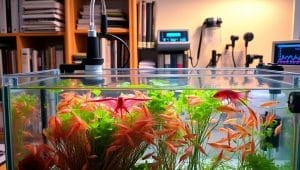
Preparing Starter Cultures
For vinegar eels, grab an empty wine bottle. Mix equal parts apple cider vinegar and dechlorinated water. Add thin apple slices as food. These wiggly noodles reproduce quickly in this acidic environment – perfect for feeding tiny fish fry.
Microworms thrive in plastic containers with breathing holes. Line the bottom with instant mashed potatoes. Add starter cultures and seal with filter floss-stuffed lids. Within days, you’ll see wriggling masses ready for harvest.
Daily Maintenance and Monitoring
Check cultures every morning. Healthy vinegar eel setups stay slightly cloudy with minimal odor. For microworms, watch for crawling patterns on container walls – a sign of active populations.
Three key maintenance tasks:
- Skim floating debris with a pipette
- Add fresh apple slices weekly
- Keep temperatures between 68-75°F
Harvest vinegar eels by placing filter floss in the bottle neck. Pour dechlorinated water over it – the eels swim through into clean water. This easy culture method ensures constant meals for growing fish fry without overwhelming your schedule.
Optimizing Water Quality and Temperature
Your tiny food factories depend on precise conditions to thrive. Like Goldilocks’ porridge, every culture needs just-right settings to multiply effectively. Nail these parameters, and you’ll enjoy bountiful harvests that keep your aquarium buzzing with life.
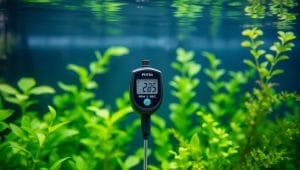
Balancing Chemistry for Success
Daphnia demand cool 68°F water and bright light for breeding booms. Brine shrimp eggs hatch fastest at 74-82°F – perfect for quick turnarounds. Use simple aquarium heaters or ice packs to maintain these ranges.
Oxygen levels make or break your cultures. Add air stones to containers housing grindal worms and white worms. Monitor pH weekly with test strips:
- Brine shrimp: 7.5-8.5 pH
- Daphnia: 6.2-7.5 pH
- Microworms: Neutral conditions
Seasonal Adjustments Made Simple
Summer heatwaves? Float frozen water bottles in culture containers. Winter chills? Stick-on reptile tank heaters maintain warmth. Temperature stability matters more than exact numbers for most species.
Three pro tips for consistent results:
- Group cultures with similar needs
- Label containers with ideal temps
- Check water parameters at dawn
Watch your tiny livestock flourish when their environment mirrors nature’s rhythms. Your fish will reap the rewards through healthier, nutrient-packed meals!
live food culture: Maximizing Benefits for Your Aquarium
What if every meal could spark your fish’s natural instincts while boosting their health? The secret lies in blending nutrient-rich prey with prepared options. This balanced approach prevents gaps in nutrition while keeping your aquatic friends engaged.
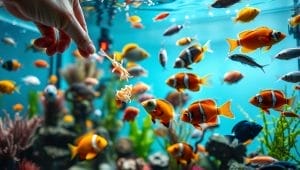
Creating a Thriving Meal Plan
Start by offering live options 2-3 times weekly alongside quality flakes or pellets. Breeders preparing for spawning might increase this frequency temporarily. Observe how your community reacts – plump bellies and active hunting signal success.
Three strategies ensure dietary balance:
- Rotate between brine shrimp, daphnia, and microworms weekly
- Use vitamin-enriched flakes on non-live feeding days
- Target feed recovering fish with extra protein boosts
Transition gradually if switching from commercial fish food. Begin with one live meal weekly, increasing as your pets adjust. This method prevents digestive stress while building their hunting skills.
Pair these practices with regular water checks. A balanced aquatic diet strengthens immunity and coloration without compromising tank conditions. Watch fry grow faster and shy species gain confidence through this mixed feeding approach.
Your observations matter most. Note which meals disappear fastest and adjust portions accordingly. This responsive method keeps your aquarium vibrant while honoring each inhabitant’s unique needs.
Preventing Overfeeding and Water Quality Issues
Your fish’s health starts with portion control—a skill that keeps their home clean and vibrant. Finding the right balance protects both your pets and their environment from common pitfalls.
Common Mistakes and How to Avoid Them
Many aquarists accidentally harm their tanks by offering too much food at once. Uneaten meals decay rapidly, spiking ammonia levels that stress fish. Watch for these signs:
- Cloudy water or algae blooms
- Fish ignoring meals after initial bites
- Debris accumulating in substrate corners
Practical Feeding Tips
Use the two-minute rule: offer only what your community consumes completely. Adjust amounts seasonally—fish eat less in cooler temperatures. Three proven strategies:
- Feed small portions twice daily instead of one large meal
- Use a turkey baster to remove uneaten bits immediately
- Skip meals if fish appear disinterested
Always make sure to test water weekly. Stable conditions let you enjoy active, colorful fish without constant maintenance. Your tank becomes a self-cleaning ecosystem when feeding aligns with nature’s rhythms!
Ensuring a Balanced Diet for Aquarium Fish
Your aquarium’s health hinges on more than just clean water—it starts with what’s on the menu. The Merck Veterinary Manual confirms that dietary variety is essential for covering all nutritional needs. You’ll master meal plans tailored to your pets’ biology, whether they’re plant-munching herbivores or protein-loving carnivores.
Begin by identifying your fish’s natural eating habits. Guppies thrive on mixed meals, while cichlids need meatier options. Combine nutrient-rich options like baby brine shrimp with quality flakes to create a complete nutritional profile. Fry require smaller portions, while adults benefit from energy-dense choices.
Three keys to success:
- Rotate protein sources weekly to prevent deficiencies
- Match portion sizes to life stages and species size
- Observe eating behaviors to adjust offerings
This approach strengthens immunity and enhances coloration. Your finned friends will showcase vibrant energy when their meals mirror nature’s perfect balance!
FAQ
How do live foods improve my fish’s health compared to processed options?
Fresh options like brine shrimp or microworms provide higher protein levels, essential vitamins, and natural enzymes that support digestion and vibrant coloration. They mimic what fish eat in the wild, promoting stronger immune systems and energy.
What equipment do I need to start culturing at home?
You’ll need clean containers (like jars or plastic tubs), air pumps for oxygenation, and starter cultures. A thermometer and pH test kit help maintain ideal conditions. Most setups cost less than and fit in small spaces.
Can I feed live foods to all types of aquarium fish?
Yes, but tailor choices to your species. Betta fish thrive on vinegar eels, while goldfish prefer daphnia. Research your fish’s natural diet—saltwater tanks often benefit from copepods, whereas guppies enjoy baby brine shrimp.
How often should I harvest live foods for feeding?
Harvest small amounts daily to ensure freshness. For fast-reproducing cultures like microworms, take 1–2 teaspoons every other day. Avoid depleting entire colonies—leave enough organisms to sustain the population.
Will live foods affect my tank’s water quality?
When fed properly, they’re less likely to cloud water than excess flakes. Rinse cultures in dechlorinated water before feeding to remove debris. Feed only what your fish consume in 2–3 minutes to prevent waste buildup.
What’s the easiest live food for beginners to culture?
Brine shrimp are forgiving and hatch in 24–48 hours using a simple saltwater setup. Microworms also work well—they thrive in oatmeal-based media and require minimal maintenance. Both are excellent for fry and small species.
How do I prevent overfeeding with live options?
Use a turkey baster or pipette to control portions. Observe your fish during feeding—stop once their hunting slows. Remove uneaten organisms (like worms) quickly, as some may burrow into substrate and decay.
Can I combine live foods with commercial diets?
Absolutely! Rotate between fresh cultures and high-quality pellets or algae wafers for balanced nutrition. For example, offer daphnia in the morning and sinking pellets at night. Variety ensures your fish get all necessary nutrients.





